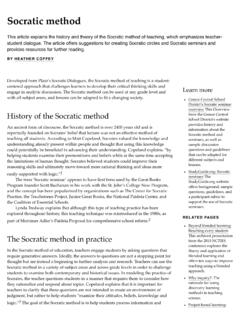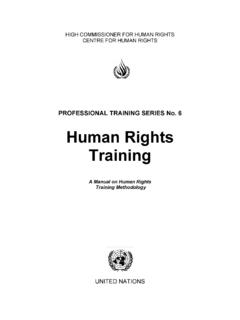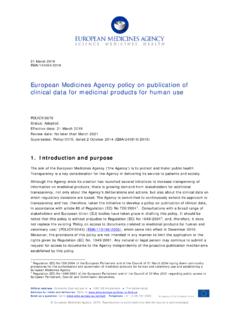Transcription of Privacy and Confidentiality: Issues in Research
1 A P R E S E N T A T I O N O F N O R T H E A S T E T H I C S E D U C A T I O N P A R T N E R S H I P A P R I L 2 0 1 2 Privacy and Confidentiality: Issues in Research Defining Confidentiality The notion of confidentiality is founded on the principle of respect for autonomy. Confidentiality is taken to mean that identifiable information about individuals collected during the process of Research will not be disclosed without Defining Confidentiality The concept of confidentiality is closely connected with anonymity. However, anonymization of data does not address all the Issues raised by concerns about confidentiality. Confidentiality also means not disclosing any information gained from an interviewee, deliberately or accidentally, in ways that might identify an Confidentiality in Research In a Research context, confidentiality means (1) not discussing information provided by an individual with others, and (2) presenting findings in ways that ensure individuals cannot be identified (chiefly through anonymization).
2 1 Privacy protecting Research participants right to Privacy requires respect for their autonomy, their right to self-determination, as well as their general welfare. The need for Privacy is a function of generally accepted social norms and individual expectations about what information about oneself should and should not be known to Privacy in Public Health In public health, there is an unprecedented emphasis on protecting an individual s private health information (PHI). In response to rising attention on this issue, recent legislative trends attempt to restrict or prohibit the exchange of PHI to health care providers and health insurers.
3 The HIPAA Privacy Rule was implemented in 2003 and was intended to protect individuals ability to obtain health insurance Privacy in Public Health Privacy concerns have also been heightened with the ability to store and disseminate vast electronic datasets. In response, health researchers, including social and behavioral scientists, have had to modify their practices and submit their Research procedures to greater Privacy in Qualitative Research For qualitative researchers, such as in the use of interviews, maintaining respondent confidentiality while presenting rich, detailed accounts of social life presents unique challenges.
4 These challenges are not adequately addressed in the literature on Research ethics and Research Breaching Confidentiality in Medicine Consequences of breaches in the Privacy of medical records (protected health information) are extremely serious. Negative effects include inappropriate and unjustified employment termination, loss of individual health insurance, and illegal use of one s identity in a host of ways, from charges on credit cards to passport Breaking Confidentiality: Deliberate Disclosure It is recognized that there may be occasions when researchers feel the need to intentionally and knowingly break confidentiality.
5 For example, to protect public safety, researchers might be expected to (or be required to) break the confidence of a participant if they disclose having committed or being about to commit a Deliberate Disclosure- Legal Requirements Similarly, researchers may feel a moral duty to disclose information if a study participant reports being a victim of crime, or is perceived as being at risk of harm to themselves or Legal and regulatory frameworks influence how these Issues are dealt with. Legal Requirements .. Tarasoff v. Regents of the University of California 1976 Supreme Court Decision: Mandated that mental health professionals have a duty to protect individuals by notifying authorities if they suspect a patient is a threat of bodily harm to themselves or others.
6 Similar mandated reporting laws exist at the state and federal level for those working in health social services and education, such as instances of suspected child abuse or neglect. Breaking Confidentiality: Accidental Disclosure Through anonymization, researchers seek to protect Research participants from the accidental breaking of confidentiality. Ethical guidelines and methods textbooks all note the importance of anonymizing Research participants through the use of Breaking Confidentiality: Deductive Disclosure Deductive disclosure, also known as internal confidentiality, occurs when the traits of individuals or groups make them identifiable in Research reports.
7 For example, if a researcher studying teachers named the school district where the Research occurred, someone with knowledge of the school district could likely identify individual teachers based on traits such as age, gender, and number of years with the school Deductive Disclosure .. Given that qualitative studies often contain rich descriptions of study participants, confidentiality breaches via deductive disclosure are of particular concern to qualitative researchers. As such, qualitative researchers face a conflict between conveying detailed, accurate accounts of the social world and protecting the identities of the individuals who participated in their Example of Deductive Disclosure One of the most famous cases of deductive disclosure involves a researcher s ethnographic Research , which was turned into a book.
8 The author s data came from a small, remote community. The Research participants were able to identify themselves and their neighbors in the book, even though their real names had not been used. Relationships in the community were strained because of what was written, and the members of the community felt betrayed and humiliated by the Preventing Disclosure In order to prevent accidental or deductive disclosure, in some cases researchers may feel it is necessary to avoid publication altogether, or to omit certain aspects of their data or individual cases, in order to protect people s identities. This is more common especially in cases where dramatic or extreme situations are Measures to Protect Confidentiality: In Data Collection First, Issues of confidentiality are addressed at the time of data collection.
9 At this point, researchers and sociologists make assurances of confidentiality, typically via consent form statements such as, All identifying characteristics, such as occupation, city, and ethnic background, will be changed . Researchers typically present confidentiality agreements at the beginning of the data collection protecting Confidentiality Ongoing Needs Discussing confidentiality at the outset is necessary for acquiring informed consent and for building trust with respondents. However, these discussions occur without knowledge of the specific information subsequently shared by the respondent. Furthermore, discussions about informed consent and confidentiality are rarely ongoing; once the consent form is signed, researchers lack a standardized way of returning to the issue of confidentiality and data use with protecting Confidentiality: Data Cleaning Second, confidentiality is addressed during data cleaning.
10 Researchers remove identifiers to create a clean data set. A clean data set does not contain information that identifies respondents, such as a name or address (such identifying information might be stored elsewhere, in separate, protected files).3 Potential Identifiers Some identifiers are easily recognized and dealt with. For example, the names of respondents can be replaced with pseudonyms. Addresses can be deleted from the file once they are no longer needed. However, for both quantitative and qualitative data sets, unique combinations of traits can be used to identify respondents. This is particularly true for respondents who have faced unusual life events or who are unique in some Contextual Identifiers In quantitative studies of cancer, individuals with rare forms of cancer, such as brain tumors, can be identified with a few pieces of information such as census tract, cancer type, and gender.












